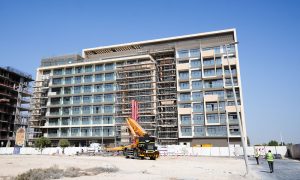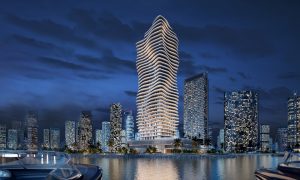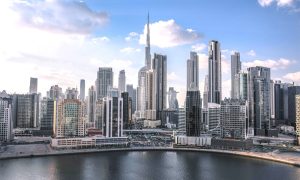The next step: Chris Roberts, Eltizam, interview
Eltizam’s CEO on how asset and property managers are using data and tech to streamline property operations

30 years ago, when a real estate developer in Dubai built a property, the intention was always to lease it out straight away, with minimal regard for how the project was maintained or operated. In fact, it was not uncommon to see buildings less than 15 or 20 years old being demolished to make way for newer, larger developments.
But once Dubai’s real estate industry started gravitating towards building projects that were larger and higher in scope and size than anything that had come before, this model was no longer sustainable. With mega developments like Business Bay, Downtown Dubai and Dubai Marina coming up, it was no longer viable to go back to the drawing board every couple of decades or so.
Developers had to start thinking long-term and viewing the longevity of their real estate assets as an essential part of their business model and strategy. This is where facility and asset management firms came in – tasked not only with building operation and maintenance, but also with ensuring that essential systems such as MEP and fire and life safety systems operated efficiently and effectively.
“When I came here in 2006 originally, it was very much about implementing the FM model and Dubai was the first one to accept the FM model. Then 2008/2009 happened and things became very restricted in terms of cash, and therefore by the cost of maintaining that asset. Then it became about looking at the lifecycle of the whole asset,” says Chris Roberts, CEO of Eltizam Asset Management Group, a UAE-based company that consists of a range of building service providers that manage and maintain thousands of buildings across the country.
“Developers are fantastic at building great projects, but they don’t think about how they can maintain it and add life to it. Back in 2006/2007/2008, you had a lot of developers building something because [they could]. It was a case of ‘I can build it, stick my name on it, and off I walk’.
“But by 2008/2009, you had all these developers who realised that they were going to be here for years. They weren’t going to build just one building, they were looking to build 15 towers for instance, and therefore they wanted to protect their brand. They could create their own internal teams to do that and have the huge costs associated with that, or they could find a partner who’s going to take on the asset for the long term,” Roberts says.
“You can have PM and FM companies, but Eltizam looks at the whole asset and therefore there are no complications when you’re looking at a 25-year or 30-year lifecycle project, because we know how it’s going to be maintained, how it’s going to be managed and how we can plan around that.”
Despite the plethora of facilities management and asset management firms in the market, Robert believes that having a long-term view for its project portfolio gives Eltizam a competitive advantage in a rapidly changing market.
Established in Abu Dhabi in 2009, Eltizam was initially set up to manage and maintain real estate assets. Over time, it has expanded from an initial 14 buildings to 155, and from 300 units to a mammoth 44,000. It is now expanding into Saudi Arabia, Oman, Kuwait and Bahrain.
Shortly after Roberts joined the company, there was a complete strategic change within the organisation, leading to the establishment of several companies within the group – Tafawuq Facility Management, Tafawuq Project Services, Three60 Communities, Three60 Leisure, Three60 Energy and Three60 Real Estate.
“As an organisation, we weren’t really pushing ourselves to the boundaries, we were just doing particular projects. Once I joined in February 2014, we decided to do a complete strategic change and we created Eltizam, which is a physical asset management company. By that, I mean that we take an asset that’s already been built, and we manage and maintain it, and add life to it.
“We now have just over 115 buildings in the UAE and five large communities in the UAE and Oman that are between 3,000 and 5,000 units each. We’ve gone from approximately $8.13m in revenues in 2013, to this year alone touching nearly $81.6m. It’s quite significant growth for us.”
Having established itself as one of the leading physical asset management companies in the GCC, Eltizam now manages assets worth in excess of $16.3bn. It currently employs 1,400 people after starting out with just 140, and revenues are forecast to surpass $136.1m by 2021, as a direct benefit of its ambitious Vision 21 programme.
Launched in 2017, Vision 21 is the five-year business strategy programme that will oversee Eltizam’s transition from a growth company to a customer company. In fact, the group recently announced that it has set aside $55m to fund mergers and acquisition activities in the GCC in 2019 and 2020.
Viewed as a natural strategic step for the company, the fund will allow it to acquire companies from multiple sectors, including facilities management, owners’ association management and property management. There are already strategic joint ventures and M&A agreements in place to facilitate expansion in Oman, Kuwait and Saudi Arabia, the company says, adding that it is in discussions with several companies and aims to finalise deals by the end of the year.
Another crucial part of the Vision 21 programme is Eltizam’s investment of $5m in next-generation property technologies over the next three years. Roberts firmly believes that this investment will help solidify the group’s status in the market and give it an increased competitive edge, especially as the way buildings are constructed is changing in the region.
With regional governments and municipalities now mandating the use of BIM on construction projects, there is now a wealth of data generated during the construction process, he explains. This data is crucial information for companies like Eltizam, which relies on it to plan and structure its operation and maintenance plans for the assets under its control.
“I would say that [the use of BIM] has been the biggest fundamental change in the last four years. You used to have an FM consultant who’d come in, do the overarching design and plan, and then pick an FM company [to operate and maintain the building]. Nobody looked at it as a whole asset. I want to see [the data] from a management perspective, I want to see it from an owners’ association or property management perspective. I want to see how the building is put together.
“For example, we took over a project a few years ago and we got the BOQ for the assets. We then did a review of all the assets in 2015. [According to the BOQ], we had 91,000 assets on our books that we had to maintain on that property. Now, this all came from the contractor, who insisted that we had 91,000 assets. But when we took a couple of months to do a quick review, we found that all of a sudden, we had 146,000!
“So, my lifecycle model changes completely, in the sense that it’s now not valued at $4m every three years [for example], but it’s actually valued at $6m. I’ve now got to make sure that my fund is healthy enough to replace these assets over the time period.
“That part of the technology is really vital, as is how you – as an asset manager – interact with the contractor and the developer to get that information in the first place. That sets out, in the long term, the planning of the building and the whole asset. The asset is like a big data machine and what you need to do is capture all of that big data from the building,” Roberts asserts.
Traditionally, several models are used to operate and maintain a real estate asset, each addressing specific needs and wants that a property or facilities manager might have. However, this is a cumbersome, time-consuming process and Roberts reveals that Eltizam’s investment in technology includes the development of a streamlined system that has all the data from the building feed into it and translated into information that can be used by its asset management teams, as well as property owners and tenants, all easily accessible on smartphones or personal computers.
“You can take someone on a complete journey – if they want to lease a particular unit, they can go into the app, find a property they like, do a 360-degree viewing of that property, compare it to other properties within that price range, and see how the building is graded as well.”
Users can even get their Ejari done using the system, he adds, and tenants can register interest in flats, negotiate and pay landlords, and even hire movers. The functionality of the app means tenants can also use it to enhance their living experience, whether by booking fitness classes or cleaners, or highlighting faulty equipment or maintenance issues.
Furthermore, the app is also beneficial to owners and owners’ associations, he adds, as it allows them to communicate directly with property managers, check on multiple apartments, keep track of service charges, and so on.
“When you get to the corporate perspective, I can look at one building and see the exact cost of the FM running there, how it’s being maintained, and the additional costs being incurred. Monthly reports to the owners’ association can also be produced, while the asset manager can look at the data and see what the costs are from an energy management perspective. It takes over the whole CAFM system as well, thereby driving the maintenance plans and reducing the utilisation of manpower.”
Finally, Roberts stresses that the industry is on the cusp of a paradigm shift in how technology is used to manage built environments and make cities smarter. With the company exploring how the Internet of Things (IoT), artificial intelligence (AI) and blockchain technologies can help the business over the coming months and years, a pilot project involving the deployment of IoT temperature and water sensors at one of its flagship projects in Abu Dhabi is already underway.
While the data generated from the pilot project will be used to aid in FM operations for the property asset, Roberts says developers and governments need to pay attention to how the capture and use of big data can inform future construction and development.
“I think this is definitely the next step. At the moment, we capture big data but we’re using it from a management and maintenance perspective. Actually, the developer should be using that information at the same time, to go and plan for the next building or project.
“The thing about smart cities is that it’s not just tech-driven. It’s driven by driving down efficiencies and making it a lot easier to do business in the city. Dubai is probably at the forefront of the movement, in that it’s not taken a 50,000sqm or 1,000,000sqm project and called it a smart city. Instead, it’s taken the whole city. In fact, the UAE is looking at it as a whole – how they do business here and how they can make it more efficient to do that.
“It comes down to pathways – we’ve made it very easy for a developer to go and build a building and we’ve made it very transparent for owners to go and buy in that building, but what’s Eltizam’s responsibility? To maintain and manage the asset, to make it very easy and transparent, but to also utilise technology to make it very efficient.
“Whatever we’ve done from a property or facilities manager perspective in the past 10 years, that’s not what is going to happen in five years’ time, it’s not what’s going to happen in the next year. Now we’re thinking about what’s going to happen in five years’ time and how we can get smarter in this environment, while cutting down on manpower and therefore the cost of managing and maintaining an asset,” he concludes.
















